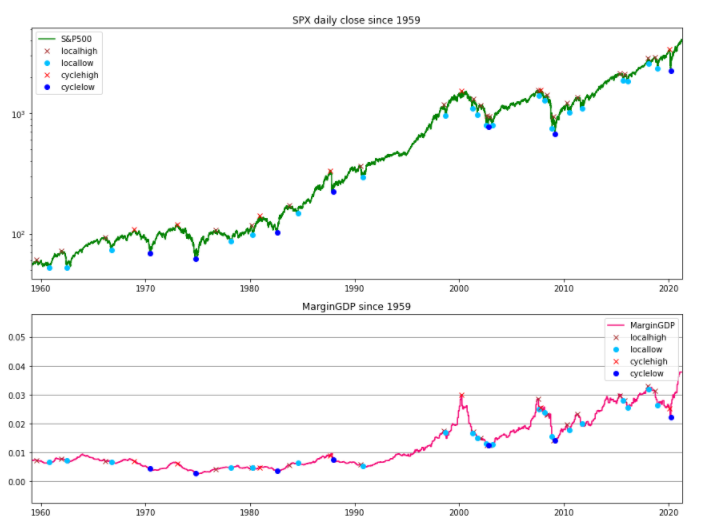There is a saying that there are 2 major market forces: greed and fear. Margin Debt data illustrates this very well and it could be sending a major signal – just now.
The latest market trend is to lead all those stimulus checks that are supposed to land into stocks. This has been enough to quell inflation fears (at least for now) and propel S&P500 (US500) above 4000 points. One would wonder – with so much cash around, why would anyone still borrow against stockholdings? Well, the answer is simple – to buy even more. Just like with option calls, margin debt allows to get even greater exposure that any cash alone would allow.
Start investing today or test a free demo
Create account Try a demo Download mobile app Download mobile appIf you study the history of the data in relation to GDP, you might notice that buying stocks on margin really took off in the 90’s. The relationship peaked at around 3% at the top of the dot-com bubble and then similar levels called the tops in 2007/8, 2015 and 2018. Now all this has been smashed and we are approaching 4% and seemingly sky is the limit.
 Margin debt to GDP is the highest in history - by a good margin. Source: XTB Research
Margin debt to GDP is the highest in history - by a good margin. Source: XTB Research
However, changes could be more important than levels for market dynamics. Here we can see that margin debt to GDP just increased by more than 60% y/y and it happened to increase by at least 59% only 3 times before since 1960 – each time being very close to call market top: 1983 (local high), 2000 (bull market high), 2007 (bull market high).
 Each previous rise in margin debt to GDP by around 60% y/y called the market top - will it be the 4th time? Source: XTB Research
Each previous rise in margin debt to GDP by around 60% y/y called the market top - will it be the 4th time? Source: XTB Research
Could this be different this time around? Sure it could. The Fed could propel the current bull run beyond anything we’ve ever seen, crushing all the historical parallels. But if you add the fact that this metric was NEVER above 0% when S&P500 saw a bear market low for the past 60 years, it’s at least worth watching.
The content of this report has been created by XTB S.A., with its registered office in Warsaw, at Prosta 67, 00-838 Warsaw, Poland, (KRS number 0000217580) and supervised by Polish Supervision Authority ( No. DDM-M-4021-57-1/2005). This material is a marketing communication within the meaning of Art. 24 (3) of Directive 2014/65/EU of the European Parliament and of the Council of 15 May 2014 on markets in financial instruments and amending Directive 2002/92/EC and Directive 2011/61/EU (MiFID II). Marketing communication is not an investment recommendation or information recommending or suggesting an investment strategy within the meaning of Regulation (EU) No 596/2014 of the European Parliament and of the Council of 16 April 2014 on market abuse (market abuse regulation) and repealing Directive 2003/6/EC of the European Parliament and of the Council and Commission Directives 2003/124/EC, 2003/125/EC and 2004/72/EC and Commission Delegated Regulation (EU) 2016/958 of 9 March 2016 supplementing Regulation (EU) No 596/2014 of the European Parliament and of the Council with regard to regulatory technical standards for the technical arrangements for objective presentation of investment recommendations or other information recommending or suggesting an investment strategy and for disclosure of particular interests or indications of conflicts of interest or any other advice, including in the area of investment advisory, within the meaning of the Trading in Financial Instruments Act of 29 July 2005 (i.e. Journal of Laws 2019, item 875, as amended). The marketing communication is prepared with the highest diligence, objectivity, presents the facts known to the author on the date of preparation and is devoid of any evaluation elements. The marketing communication is prepared without considering the client’s needs, his individual financial situation and does not present any investment strategy in any way. The marketing communication does not constitute an offer of sale, offering, subscription, invitation to purchase, advertisement or promotion of any financial instruments. XTB S.A. is not liable for any client’s actions or omissions, in particular for the acquisition or disposal of financial instruments, undertaken on the basis of the information contained in this marketing communication. In the event that the marketing communication contains any information about any results regarding the financial instruments indicated therein, these do not constitute any guarantee or forecast regarding the future results.

